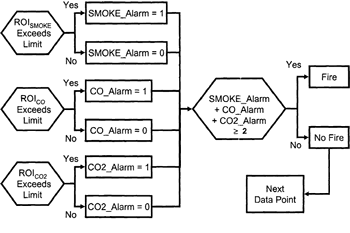Fire Alarm Algorithm Using Smoke and Gas Sensors
U. S. Patent No. 7,142,105, issued November 28, 2006
 Quickly
detecting the presence of a fire is critical in many situations. While the
ordinary smoke detector is adequate for many situations, it is susceptible
to false alarms. This situation is unacceptable on board aircraft or spacecraft
or in high-value facilities where the cost of evacuation is prohibitive. An
improved fire detection algorithm is obtained by combining measurments of
smoke, carbon dioxide and carbon monoxide. Carbon monoxide is produced from
smoldering fires, which are typically small and release little heat. A rate-of-rise
criterion can be used to determine if either of the gases is increasing. When
the rate exceeds a threshold and smoke is detected, the alarm sounds. Tests
showed that this algorithm could respond more quickly to smoldering fires
than a smoke detector alone, while drastically reducing false alarms.
Quickly
detecting the presence of a fire is critical in many situations. While the
ordinary smoke detector is adequate for many situations, it is susceptible
to false alarms. This situation is unacceptable on board aircraft or spacecraft
or in high-value facilities where the cost of evacuation is prohibitive. An
improved fire detection algorithm is obtained by combining measurments of
smoke, carbon dioxide and carbon monoxide. Carbon monoxide is produced from
smoldering fires, which are typically small and release little heat. A rate-of-rise
criterion can be used to determine if either of the gases is increasing. When
the rate exceeds a threshold and smoke is detected, the alarm sounds. Tests
showed that this algorithm could respond more quickly to smoldering fires
than a smoke detector alone, while drastically reducing false alarms.
Contact Information
e-mail info@swsciences.com

